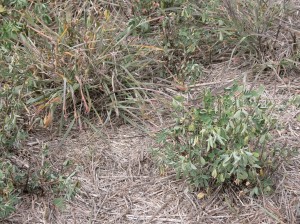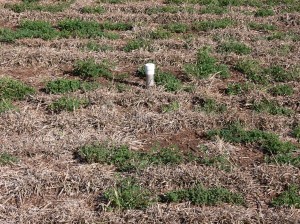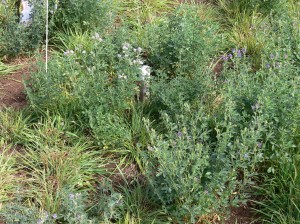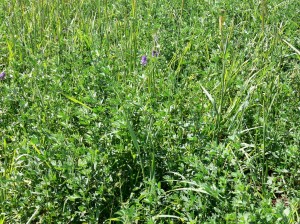Tamworth lucerne-grass mix hydrology and production experiments
Lucerne is the most widely sown and adapted perennial legume on the Northern Slopes of NSW, but has fallen from favour in recent years. One reason for lucerne’s decline is its potential when grazed for low ground cover and associated high risk of surface runoff and erosion. Lucerne’s poor performances in variable rainfall years, low growth in winter, and potential for bloat in cattle are also issues.
A lucerne-grass mix has long been held as an attractive pasture option, but producers identified several challenges when they have attempted to establish mixes, including: competition among seedlings; sowing configuration, time and rate; persistence of species; and total herbage production.
In this study, a series of field experiments (Table 1) was conducted on a Brown Vertosol soil at Tamworth Agricultural Institute from Spring 2008 to Spring 2012 to investigate competition among seedlings, sowing (configuration, time and rate), persistence (plant frequency), herbage production, soil water content and water use efficiency, ground cover and control of surface runoff and erosion of lucerne-grass mixes.
Full details of the study, including results and further information about sowing lucerne in mixes can be found in the Tamworth Proof Site key message: Lucerne-grass mixtures outperform pure grass pastures on the North West Slopes of NSW.
Table 1. Descriptions of species sowing rates, configurations and times of year for a series of experiments established at Tamworth Agricultural Institute to study lucerne-grass mixes.
| Experiment | Rates | Configuration | Time of year |
| Sowing rate and row configuration | Genesis lucerne 0.5, 1.0, 2.0 kg/ha | 1:1, 1:2 or mixed in rows | Spring 2008 |
| Premier digit grass 1.0 kg/ha | |||
| Sowing time | Genesis lucerne 1.0 kg/ha | Pure or 1:1 with grass | Spring 2008 or Autumn 2009 |
| Premier digit grass 2.0 kg/ha | Pure or 1:1 with lucerne | Spring 2008 or Autumn 2009 | |
| Herbage mass and water use efficiency and ground cover | Venus lucerne 1.0 kg/ha in mixes, 2.0 kg/ha in pure | Pure or 1:1 with each grass | Spring 2008 with Premier, Autumn 2009 |
| Premier digit grass 1.0 kg/ha in mixes, 2.0 kg/ha in pure | Pure or 1:1 with lucerne | Spring 2008 | |
| Kasbah Cocksfoot 1.0 kg/ha in mixes, 2.0 kg/ha in pure | Pure or 1:1 with lucerne | Autumn 2009 |
 |
 |
|
|
 |
|
Lucerne and Premier digit mixtures in autumn, winter, spring and summer (clockwise from top left) demonstrating water stress in autumn, low growth in winter and strong growth through the warm season. |
|
Authors and contributors
Sean Murphy, Department of Primary Industries, Tamworth, NSW
Lester McCormick, Department of Primary Industries, Tamworth, NSW
Suzanne Boschma, Department of Primary Industries, Tamworth, NSW
Further Information
- EverGraze Action – Growing and using lucerne
- Primefact (NSW DPI) – Cocksfoot
- FFI CRC Tropical Perennial Grasses Guide for NSW
- Tropical grass establishment budgets
- Lucerne and clover establishment budgets
- Primefact – Tropical perennial grass for northern inland NSW
- Boschma SP, Lodge GM, Harden S (2010) Seedling competition of lucerne in mixtures with temperate and tropical pasture species. Crop & Pasture Science 61, 411-419.


